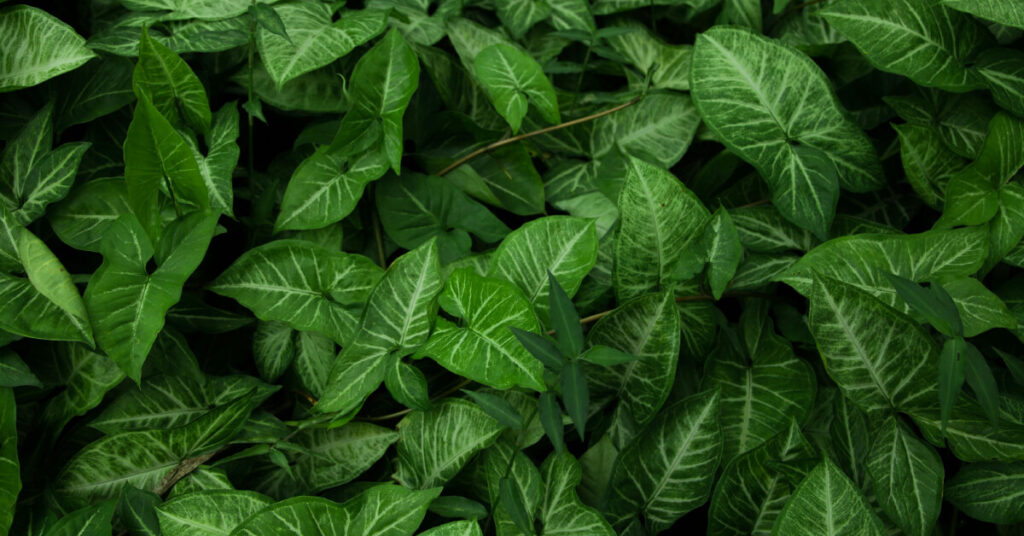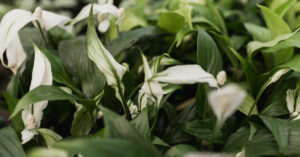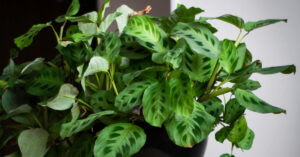With its distinctive arrow-shaped leaves and incredible ability to transform as it matures, Syngonium has earned its place as one of the most versatile and rewarding houseplants you can grow. This tropical beauty, also known as Arrowhead Plant or Nephthytis, offers something truly special – a plant that literally changes its appearance as it grows, starting with compact, arrow-shaped juvenile leaves and developing into a climbing vine with deeply lobed, mature foliage.
Native to the rainforests of Central and South America, Syngonium brings a touch of tropical elegance to any indoor space while remaining surprisingly forgiving for plant parents of all experience levels. Whether you’re drawn to the classic green varieties or the stunning variegated cultivars with their cream, pink, or silver markings, this adaptable plant will reward your care with lush, ever-changing growth.
Understanding Your Syngonium’s Growth Pattern
One of the most fascinating aspects of Syngonium care is understanding its natural growth cycle. Young plants display the characteristic arrow-shaped leaves that give the plant its common name, with leaves typically measuring 2-4 inches long. As your plant matures, it begins producing increasingly complex leaves with multiple lobes, eventually developing the classic three to five-lobed mature foliage.
This transformation happens gradually over several years, and you’ll notice the change beginning when your plant starts producing aerial roots and showing its climbing tendencies. The juvenile phase can last anywhere from 2-4 years depending on growing conditions, with better care typically accelerating the transition to mature foliage.
Many growers actually prefer to maintain their Syngonium in its juvenile form by regularly pruning climbing stems, as the arrow-shaped leaves are considered particularly attractive. However, allowing your plant to mature and climb can create a stunning living sculpture that adds vertical interest to your space.
Mastering Light Requirements
Syngonium thrives in bright, indirect light, making it perfect for those well-lit spots in your home that don’t receive direct sunlight. Place your plant near an east or north-facing window, or several feet back from a south or west-facing window where it can benefit from ample light without the harsh intensity of direct sun.
While Syngonium can tolerate lower light conditions, insufficient light will cause the plant to become leggy and lose its compact form. You’ll notice the stems stretching toward light sources, and variegated varieties may lose their distinctive coloring, reverting to plain green. In very low light, growth slows significantly, and the plant may struggle to maintain its health.
If you’re growing your Syngonium in a location with limited natural light, consider supplementing with a grow light positioned 12-18 inches above the plant. LED grow lights work particularly well and can help maintain the vibrant colors in variegated varieties while promoting healthy, compact growth.
Watering Wisdom for Healthy Growth
Getting the watering routine right is crucial for Syngonium success. These plants prefer consistently moist but not waterlogged soil, requiring a careful balance that becomes intuitive with experience. Water when the top inch of soil feels dry to the touch, typically every 5-7 days during the growing season and every 10-14 days in winter.
When watering, apply water slowly and evenly across the soil surface until it begins draining from the bottom holes. This ensures the entire root system receives moisture while preventing dry pockets that can stress the plant. Always empty any water that collects in the saucer within 30 minutes to prevent root rot.
Syngonium is sensitive to both overwatering and underwatering, showing distinct signs of distress with each condition. Overwatering typically causes yellowing leaves that feel soft and mushy, while underwatering leads to crispy, brown leaf edges and wilting. During winter months, reduce watering frequency as the plant’s growth slows and it requires less moisture.
Creating the Perfect Soil Environment
Your Syngonium will thrive in a well-draining potting mix that retains some moisture while allowing excess water to escape freely. A high-quality potting mix amended with perlite or orchid bark works excellently, or you can create your own blend using equal parts potting soil, peat moss or coco coir, and perlite.
The key is achieving a balance between moisture retention and drainage. Syngonium roots need consistent moisture but will quickly rot in soggy conditions. Adding organic matter like compost or worm castings can improve soil structure while providing gentle nutrition for steady growth.
Repot your Syngonium every 1-2 years or when it becomes rootbound, typically indicated by roots growing through drainage holes or circling the pot’s interior. Choose a container only one size larger than the current pot, as Syngonium prefers to be slightly rootbound and can struggle in overly large containers.
Temperature and Humidity Management
Syngonium thrives in warm, stable temperatures between 65-80°F (18-27°C), making it well-suited to typical indoor environments. These tropical plants are sensitive to cold drafts and temperature fluctuations, so keep them away from air conditioning vents, heating sources, and frequently opened doors or windows.
Humidity plays a crucial role in Syngonium health, with these plants preferring levels of 50-60% or higher. In dry indoor environments, especially during winter heating seasons, you may need to increase humidity artificially. Group plants together, use a humidifier, or place the pot on a pebble tray filled with water to create a more humid microclimate.
Low humidity often manifests as brown, crispy leaf edges and increased susceptibility to spider mites. If you notice these symptoms, address humidity levels before assuming other care issues. Regular misting can help temporarily, but avoid misting variegated varieties excessively as this can promote fungal issues on the colorful foliage.
Fertilizing for Vibrant Growth
During the growing season (spring through early fall), feed your Syngonium monthly with a balanced, water-soluble fertilizer diluted to half strength. A 10-10-10 or 20-20-20 fertilizer works well, providing the balanced nutrition these plants need for healthy foliage and steady growth.
Avoid fertilizing during winter months when growth naturally slows, as excess nutrients can build up in the soil and potentially burn the roots. Signs of over-fertilization include brown leaf tips, excessive soft growth, and salt buildup on the soil surface or pot rim.
Organic fertilizers like compost tea or diluted fish emulsion can also work well for Syngonium, providing gentler nutrition that’s less likely to cause burning. Whatever fertilizer you choose, always apply it to moist soil to prevent root damage and ensure even distribution.
Pruning and Shaping Your Plant
Regular pruning helps maintain your Syngonium’s shape and encourages bushier growth. Pinch or cut growing tips just above a leaf node to promote branching, creating a fuller, more compact plant. This technique works particularly well if you want to maintain the juvenile arrow-shaped leaves rather than allowing the plant to mature and climb.
For climbing varieties, you can provide support with a moss pole, trellis, or stakes, allowing the plant to express its natural growth habit. As the plant climbs, it will produce larger, more mature leaves and develop a completely different character than its juvenile form.
Remove any yellowing, damaged, or diseased leaves promptly by cutting them at the base of the stem. This prevents potential disease spread and keeps your plant looking its best. Pruning is best done during the growing season when the plant can quickly recover and produce new growth.
Common Challenges and Solutions
Even with proper care, Syngonium can face several common issues. Spider mites are the most frequent pest problem, especially in dry conditions. These tiny pests cause stippling on leaves and may produce fine webbing. Increase humidity and treat with insecticidal soap or neem oil for effective control.
Root rot from overwatering is another serious concern, typically presenting as yellowing leaves, soft stems, and a musty smell from the soil. If caught early, you can often save the plant by removing affected roots, repotting in fresh soil, and adjusting your watering routine.
Leggy growth usually indicates insufficient light, while loss of variegation in colored varieties often signals the same issue. Moving your plant to a brighter location typically resolves these problems, though it may take several months to see significant improvement.
Expanding Your Collection Through Propagation
Syngonium propagates easily through stem cuttings, making it simple to expand your collection or share with friends. Take 4-6 inch cuttings that include at least one node (the bump where leaves emerge), and place them in water or moist potting mix. Roots typically develop within 2-4 weeks in warm conditions.
For best results, take cuttings during the growing season when the plant’s energy is focused on new growth. Dip cut ends in rooting hormone to speed the process, though this isn’t strictly necessary for Syngonium. Once roots are well-developed, transplant water-rooted cuttings to soil gradually to prevent transplant shock.
You can also propagate Syngonium by division when repotting, carefully separating natural offsets that have developed their own root systems. This method typically has higher success rates than cuttings and produces mature plants more quickly.
Your Journey with Syngonium Continues
Growing Syngonium successfully is ultimately about understanding and responding to your plant’s needs while appreciating its unique growth journey. This remarkable plant offers both beauty and adaptability, rewarding attentive care with years of lush, ever-changing foliage that brings tropical elegance to your indoor garden.
Whether you choose to maintain your Syngonium in its compact juvenile form or allow it to climb and mature, you’re embarking on a rewarding relationship with one of the most versatile houseplants available. With proper care, your Syngonium will not only survive but thrive, potentially becoming one of the most cherished plants in your collection.




